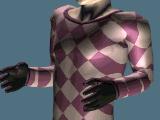


Selects the Checker map type and adds it to the current material in the Material Editor sample window.

Checker-mapped material
The Checker map applies a two-color checkerboard pattern to the material. The default checker map is a pattern of black and white squares. Checker maps are 2D procedural maps. The component checkers can be either colors or maps.
Tip: Turning on Noise for a Checker map can be an effective way to create irregular patterns with a natural appearance.
For the Checker map type, you can set or modify the following parameters in the Coordinates rollout:
Texture: Click to use the checker pattern as a texture map applied to a surface.
Environ Mapping: Click to use the checker pattern as an environment map. Then select the type of environment coordinates from the list: spherical, cylindrical, shrink-wrap, or screen.
Offset: Changes the position of the checker pattern in UV coordinates. The checker pattern moves in relation to its size. For example, if you want to shift the checker pattern its full width to the left, and half its width downward from its original position, you enter -1 in the U Offset field and 0.5 in the V offset field.
UV/VW/WU: Changes the mapping coordinate system used for the checker pattern. The default UV coordinates project the checker pattern onto the surface like a slide projector. The VW and WU coordinates rotate the checker pattern so that is perpendicular to the surface.
Tiling: Determines the number of times the checker pattern is tiled (repeated) along each axis.
Mirror: Mirrors the checker pattern left-to-right (U axis) and/or top-to-bottom (V axis).
Angle: Rotates the checker pattern around its center (degrees).
Blur: Affects the sharpness or blurriness of the checker map based on its distance from the view. The farther away the map is, the greater the blurring. Blur is primarily used to avoid aliasing. It’s a good idea to use a small amount of blurring for all maps in order to avoid the scintillation or aliasing that can occur when pixel details are reduced off in the distance.
Blur Offset: Affects the sharpness or blurriness of the checker without regard to its distance from the view. Blur Offset is the option to use when you want to soften or defocus the details in a map to achieve the effect of a blurred image.
For the Checker map type, you can set or modify the following parameters in the Parameters rollout:
Color #1: Sets the color of one of the checkers. Click to display the Color Selector.
Color #2: Sets the color of one of the checkers. Click to display the Color Selector.
Maps: Select or create a map to use within the area of the checker color. For example, you could put an additional checkerboard within one of the checker colors.
Swap: Switches the position of the two checkers.
Soften: Blurs the edges between the checkers. A little blurs a lot.
Checker maps have three rollouts. The controls in the Coordinates and Noise rollouts are identical to those for bitmapped materials. The Checker Parameters ("Checker Params") rollout has controls that are specific to Checker maps.
Tip: Turning on Noise for a Checker map can be an effective way to create irregular patterns with a natural appearance.
When Soften equals 0.0, there is a hard edge between the checker colors. Low positive values soften or blur the checker boundary. Larger Soften values can blur the entire material.